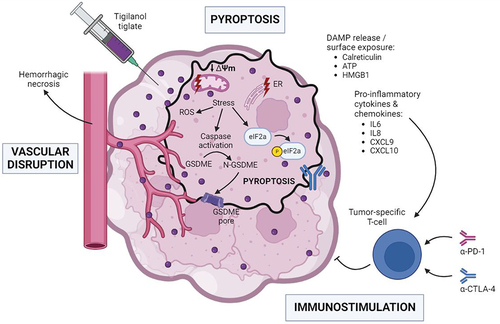Figures & data
Figure 1. Tigilanol tiglate promotes pyroptotic cell death and sensitizes to immune checkpoint inhibitors. IT administration of TT initiates mitochondrial and ER stress responses, leading to generation of ROS, induction of the ISR as illustrated by the phosphorylation of eIf2alpha, caspase activation, and subsequent GSDME-mediated pyroptotic cell death. This cell demise shows immunogenicity due to the release/surface exposure of DAMPs (e.g., calreticulin, ATP, HMGB1) together with pro-inflammatory cytokines (e.g., IL6, IL8, CXCL9, CXCL10). This cascade of events triggers a tumor-specific T cell response which can be enhanced by systemic immunotherapy with inhibitors of the CTLA-4 and PD-1 immune checkpoints. CTLA-4, cytotoxic T lymphocyte associated protein 4; CXCL, chemokine (C-X-C motif) ligand; DAMP, damage-associated molecular pattern; ER, endoplasmic reticulum; GSDME, gasdermin E; HMGB1, high mobility group box 1; IL, interleukin; ISR, integrated stress response; IT, intratumoral; PD-1, programmed cell death protein 1; ROS, reactive oxygen species; TT, tigilanol tiglate. Created with BioRender.com.

